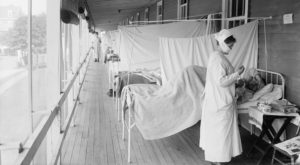Quarantines work: what history has taught us
April 3, 2020 • Uncategorized

The notion of COVID-19 social distancing seems so strange to most of us, yet quarantines for the good of public health have been around since the Middle Ages and perhaps even earlier.
The practice of separating the sick to keep other populations well was, in fact, a very early public health measure that has been credited through history for saving lives and slowing the spread of deadly diseases.
“The word quarantine comes from an Italian phrase, quaranta giorni, meaning 40 days,” said Dr. Thad Miller, Associate Professor of Health Behavior and Health Systems at the HSC College of Public Health. “During the bubonic plague, ships arriving in Venice from infected ports were required to sit at anchor before landing, to keep them at bay until the time seemed safe.”
Ships were first required to stay offshore for a 30-day waiting period, and when the outcome wasn’t as effective as expected, the time was moved to 40 days.
Sailors and passengers who remained healthy by that time were presumed to be infection free and were permitted to dock.
“Sounds familiar, doesn’t it? Some of the key cornerstones of public health are rooted in this notion of quarantine,” Dr. Miller said. “Even before the germ theory of disease was discovered, it was found that if we isolated people against infection, we could stop the spread and safeguard the health of those who had not been affected.”
During the 1918 Spanish Flu, long considered the deadliest pandemic in history, killing an estimated 30 to 50 million people worldwide, social distancing was found to be the best way of flattening the curve of infection rates. There was a greater chance of keeping people healthy through temporary separation, history shows.
Health safety isolation measures taken since then, such as those initiated during the 2003 SARS epidemic and 2014 Ebola outbreak, further reinforce this idea.
Today, with much of society working from home and going out only for basic essentials, the World Health Organization continues to advise that the course of the current COVID-19 pandemic can be changed if we all follow public health guidance.
“This centuries-old concept of quarantines to save lives is still one of the best things we have going in partnership with treatment and other prevention efforts, and every now and then we are reminded of the key role that public health plays,” Dr. Miller said.
With all eyes and ears fixed on evolving COVID-19 public health guidance right now, it seems the lessons of the past indeed have some very important bearing on the present.
“When public health is working well, it seems invisible,” Dr. Miller said. “But every now and then, in times like these, we are reminded of how important it is to our lives, and we gain a greater appreciation of its value. It’s really during the times of greatest need that public health moves to the forefront.”


Social media